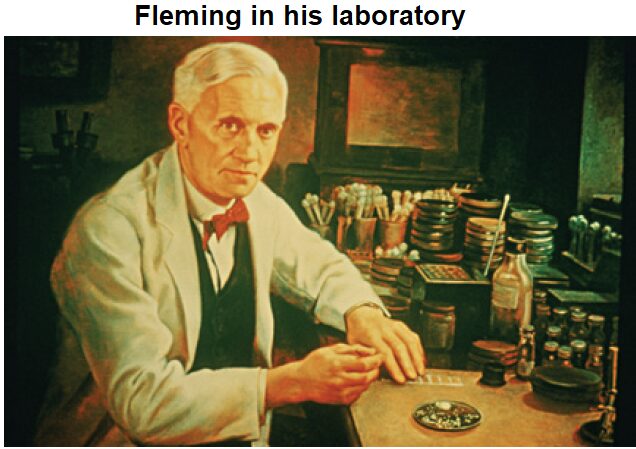The Second Golden Age of Microbiology
Introduction
- The Second Golden Age of Microbiology Involves the Birth of Molecular Biology and Chemotherapy
- The 1940s brought the birth of molecular genetics and the development of one of the greatest breakthroughs that would revolutionize medicine’s ability to treat and eliminate infectious disease antibiotics.
Molecular biology often relies on microorganisms as model systems
- Being small, easy to grow, and having fast reproductive rates, microbes are perfect research tools or model systems with which to explore the molecular workings of life and to discover general principles in biology.
- Consequently, beginning around 1940, the second Golden Age of microbiology emerged.
Here are a few of the scientists who used microbial model systems and viruses:
- George Beadle and Edward Tatum (1941) used the fungus Neurospora to demonstrate that genes direct the synthesis of proteins.
- Salvador Luria and Max Delbrück (1943) used the bacterium Escherichia coli to show that mutations could occur spontaneously.
- Oswald Avery, Colin MacLeod, and Maclyn McCarty (1944) used the bacterium Streptococcus pneumoniae to suggest that DNA is the genetic material in all cells.
- Alfred Hershey and Martha Chase (1952) used a virus that infects bacterial cells to confirm that DNA is the genetic material.
- Francis Crick (1958) used E. coli and a virus to show how the DNA genetic code works to make individual proteins.
- Again, microbes were at the forefront in answering fundamental questions that applied to all of biology.
- In addition, during this second Golden Age of microbiology, other studies illuminated the basic structural organization of microbes.
Two Types of Cellular Organization Are Realized
- The small size of bacterial cells hindered scientists’ abilities to confirm if these cells were similar to other cellular organisms in organization or if the cells were just “bags of enzymes.”
- In the 1940s and 1950s, a new type of microscope—the electron microscope—was developed that could magnify objects and cells thousands of times better than typical light microscopes.
- With the electron microscope, for the first time bacterial cells were seen as being cellular like all other microbes, plants, and animals.
- However, studies showed that they were organized in a structurally different way from other organisms.
- It was known that animal and plant cells contained a cell nucleus that houses the genetic instructions in the form of chromosomes and that the nucleus was separated physically from other cell structures by a membrane envelope.

- This type of cellular organization is called eukaryotic (eu = “true”; karyon = “nucleus”).
- Microscope observations of the protists and fungi had revealed that these organisms also have a eukaryotic organization.
- Thus, not only are all plants and animals eukaryotes, so are the microorganisms that comprise the fungi and protists.
- Electron microscope studies revealed that bacterial (and archaeal) cells had few of the internal compartments typical of eukaryotic cells.
- They lacked a cell nucleus, indicating the DNA was not surrounded by a membrane envelope.
- Therefore, members of the Bacteria and Archaea have a prokaryotic (pro = “before”) type of cellular organization and represent prokaryotes.
- Importantly, there also are many genetic and molecular differences between bacterial and archaeal cells, accounting for their split into separate and unique microbial groups.
- Incidentally, because viruses lack a cellular organization, they are neither prokaryotes nor eukaryotes.
Antibiotics Are Used to Cure Infectious Disease
- In 1910, another coworker of Koch’s, Paul Ehrlich, synthesized the first chemical capable of killing pathogens without severely damaging the tissue surrounding the infection.
- This so-called magic bullet, an arsenic-based agent called salvarsan, could cure syphilis, a serious sexually transmitted infection.
- With the birth of antibacterial chemotherapy, the use of antimicrobial chemicals to kill microbes would become an important branch of medical microbiology and medicine.
- In 1928, Alexander Fleming, a Scottish scientist, discovered a mold growing in one of his bacterial cultures.

- The mold, a species of Penicillium, killed the bacterial colonies that were near the mold.
- He named the antimicrobial substance penicillin and soon discovered penicillin would kill other bacterial pathogens, as well.
- In 1940, research headed by biochemists Howard Florey and Ernst Chain developed a way to mass produce penicillin, which would become a godsend in curing bacterial infections during World War II.

- As other antibacterial chemicals were discovered, the term antibiotic was coined to refer to those antimicrobial substances naturally produced by mold and bacterial species that inhibit growth or kill other
microorganisms. - By the 1950s, penicillin and several other antibiotics were established treatments in medical practice.
- In fact, by the mid-1960s, many health experts believed all major bacterial infections would soon become rare events due to antibiotic chemotherapy.
- What was ignored was the mounting evidence that bacterial species were becoming resistant to or tolerant of antibiotics.
- Still, antibiotics represent one of the greatest breakthroughs in medicine and they have saved millions of lives since their introduction.
Reference and Sources
- https://iopscience.iop.org/book/978-0-7503-1299-8/chapter/bk978-0-7503-1299-8ch1
- https://www.termpaperwarehouse.com/essay-on/Registered-General-Nursing-Student/192156
- https://quizlet.com/264907909/genetics-test-2-flash-cards/
- https://en.wikipedia.org/wiki/History_of_biology
- https://www.researchgate.net/publication/259881462_Oswald_Avery_DNA_and_the_transformation_of_biology
- https://courses.lumenlearning.com/boundless-microbiology/chapter/overview-of-antimicrobial-therapy/
- https://askinglot.com/what-do-viruses-have-in-common-with-eukaryotic-and-prokaryotic-cells
Also Read:
- What is Gene Expression?
- Vector: properties, types and characteristics
- Chickenpox (Varicella) and Shingles (Herpes Zoster)
- Microorganisms in Benthic Marine Environments
- Histones types and its functions
- Cold sores : Introduction, Entry, Symptoms, Diagnosis and Cure
- Carbohydrate: Structure, Functions and Types
- Immunoglobulin: Introduction, Structure and function
- Plasmid: Properties, Types, Replication and Organization
- Major histocompatibility complex (MHC): introduction, types and differences
- Microbiology Disciplines: Bacteria, Viruses, Fungi, Archaea and Protists
- CRISPR-Cas9 Gene editing tool: Introduction, Principles, Uses & Applications
